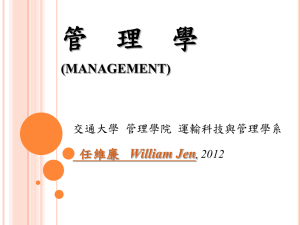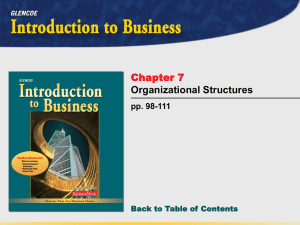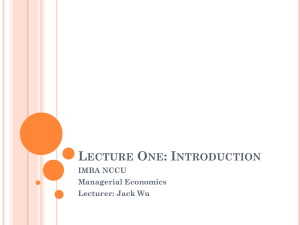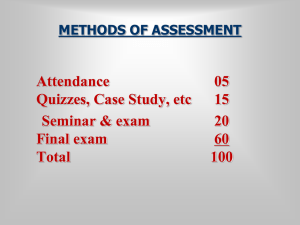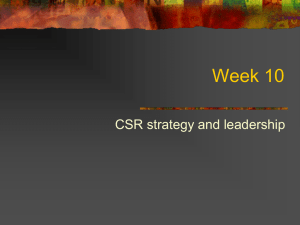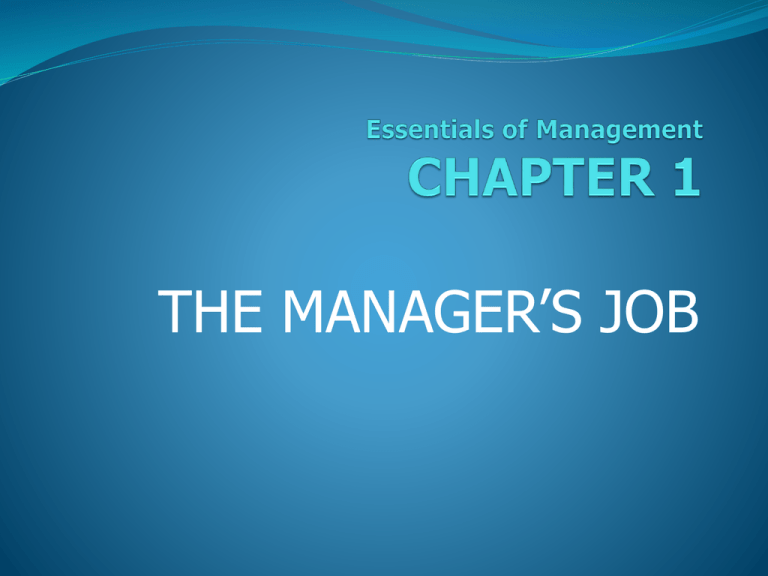
THE MANAGER’S JOB
Who Is a Manager?
A manager is person responsible for work
performance of group members.
Has formal authority to commit organizational
resources.
Management is process of using organizational
resources to achieve objectives through the
functions of planning, organizing and staffing, and
leading.
Levels of Management
1.
2.
3.
4.
Top-level managers (executives) are empowered
to make major decisions.
Term C-level manager refers to top-level manager
with “chief” in title.
Middle-level managers are layer between top- and
first-level managers.
First-level managers or supervisors manage
operatives.
Types of Managers
Functional managers supervise workers in special
activities, such as accounting, marketing, etc...
General managers are responsible for groups
performing a variety of functions.
Administrators are managers in public and nonprofit
organizations.
Entrepreneurs and small-business owners.
Team leaders are catalysts and facilitators.
The Process of Management
Managerial work is a process—a series of actions
that brings about a goal.
To achieve that objective, the manager (a) uses four
types of resources, and (b) carries out the four
managerial functions. (See slides 6 and 7. )
Resources Used by Managers
Managers use four types of resources:
1. Human resources (the workers)
2. Financial resources (the money)
3. Physical resources (tangible goods and real estate)
4. Information resources (data used to accomplish
the job; as knowledge workers, managers need
information resources)
The Four Managerial Functions
Planning is setting and attaining goals.
Organizing and staffing obtains human and
physical resources to get job done.
3. Leading influences others to achieve
organizational objectives. Leaders also execute to
accomplish goals.
4. Controlling ensures that performance conforms to
plans.
Executives plan the most; supervisors lead face-to-face
the most.
1.
2.
The Seventeen Managerial Roles
Planning:
(1) strategic planner,
(2) operational planner.
Organizing and staffing:
(3) organizer,
(4) liaison,
(5) staffing coordinator,
(6) resource allocator,
(7) task delegator. (Talent management is
concentrated in staffing coordinator and resource
allocator roles.)
The Seventeen Managerial Roles, continued
Leading:
(8) motivator and coach, (9) figurehead,
(10) spokesperson, (11) negotiator,
(12) team builder, (13) team player,
(14) technical problem solver, (15) entrepreneur.
Controlling:
(16) monitoring,
(17) disturbance handler. 44%
Managers take on right role at right time.
Managerial Roles Currently Emphasized
Managerial work has shifted substantially away from
the controller and director role.
Current emphasis is on being a coach, facilitator, and
supporter.
Many managers today work as partners with team
members to jointly achieve results.
Influence of Management Level on
Managerial Roles
Manager’s level of responsibility influences which role
he or she is likely to engage in most frequently.
Most important roles for top-level managers are
liaison, spokesperson, figurehead, and strategic
planner.
First-level manager might emphasize roles of
motivator and coach, and technical problem solver.
Management as a Practice
Management more of a practice than science or
profession.
Managers use some systematic knowledge, but rely
also on intuition.
Management not a profession in sense of being
licensed occupation.
Public trust would be gained if management became
a profession that followed an ethical code.
Management as a Practice, continued
Management would become more professionalized
with use of evidence-based management—the
systematic use of the best available evidence to
improve managerial practice.
Would mean that managers rely on both scientific as
well as local business evidence.
Study and research would be required.
The Five Managerial Skills
1.
2.
Technical skill involves and understanding of or
proficiency in specific technique.
Interpersonal skill is manager’s ability to work
effectively as a team member and to build
cooperative effort in the unit. Multiculturalism is
important subset of interpersonal skill.
Ethnocentrism.
The Five Managerial Skills, continued
3.
4.
5.
Conceptual skill is ability to see the organization as
total entity (the “big picture”). Needed for
strategic planning.
Diagnostic skill is investigating a problem and
choosing course of action to solve it.
Political skill is ability to acquire power to achieve
objectives. Understanding of people is required.
Should be a supplement to job competence.
Development of Managerial Skills
Experience and education—including formal
training—both required for development of
management skills.
Managerial skills can be learned from book or
lecture, but should then be applied using the general
learning model, as shown next.
General Learning Model
1.
2.
3.
4.
5.
Conceptual information and behavioral guidelines
Conceptual information shown by examples
Skill-development exercises
Feedback on skill utilization from others
Frequent practice plus making adjustments from
feedback
The Evolution of Management Thought
a.
b.
Daniel Wren – the white collar hobo Charles
Whiting Williams
The classical approach to management
encompasses scientific management and
administrative management.
Scientific management uses scientific methods to
increase worker productivity.
Administrative management focuses on structure
and management. Led to framework of planning,
organizing, leading, and controlling. Structure
should be determined by strategy.
The Evolution of Management Thought,
continued
a.
The behavioral approach to management
emphasizes improving management by focusing
on understanding people. Direct cornerstones of
behavioral approach:
The Hawthorne Studies. Workers in the Hawthorne
experiments reacted positively because
management cared about them. Hawthorne effect
says people respond differently when they receive
attention.
The Evolution of Management Thought,
continued
a.
b.
Theory X and Theory Y of Douglas McGregor
Theory X is traditional set of assumptions about
people, such as people disliking work, and
requiring close supervision.
Theory Y is alternative and opposite set of
assumptions emphasizing workers’ desire to
perform well and be creative.
The Evolution of Management Thought,
continued
a.
b.
c.
Maslow’s Need Hierarchy
Humans are motivated by efforts to satisfy a
hierarchy of needs.
Needs range from basic physiological ones to
those for self-actualization.
Prompted managers to think about ways of
satisfying wide range of worker needs to keep
them motivated.
The Evolution of Management Thought,
continued
a.
b.
c.
d.
Quantitative Approaches to Management
Group of methods for decision making based on
the scientific method.
Techniques include network analysis, decision
trees, computer simulations.
Frederick Taylor laid foundation for quantitative
approaches.
Operations research in WWII, true start.
The Evolution of Management Thought,
continued
a.
b.
c.
The Systems Perspective
Way of viewing problems rather than specific
approach to management.
Organization is a system or an entity of
interrelated parts.
Organization interacts with outside world,
transforming inputs (resources) into outputs
(products and services).
© 2012 Cengage Learning. All Rights Reserved.
May not be scanned, copied or duplicated, or
posted to a publicly accessible website, in whole
or in part.
The Evolution of Management Thought,
continued
a.
b.
c.
d.
The Contingency Approach
Emphasizes there is no one best way to manage
people or work.
Method that works in one situation may not work
in another.
Manager must identify key factors in the situation
that could influence results.
Common sense helps apply contingency approach.
© 2012 Cengage Learning. All Rights Reserved.
May not be scanned, copied or duplicated, or
posted to a publicly accessible website, in whole
or in part.
The Evolution of Management Thought,
concluded
a.
b.
c.
Information Technology Era and Beyond
Began in 1950s with data processing.
By 1980s, IT and Internet influenced the
management of people and work.
The Internet has had similar impact to that of
electricity in start of 20th century.
The history of management continues to be
written each year. Stay alert!


